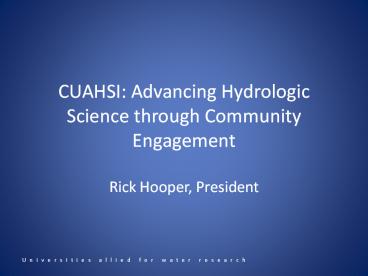CUAHSI: Advancing Hydrologic Science through Community Engagement PowerPoint PPT Presentation
Title: CUAHSI: Advancing Hydrologic Science through Community Engagement
1
CUAHSI Advancing Hydrologic Science through
Community Engagement
- Rick Hooper, President
2
What is hydrologic science?
- Hydrologic science studies the occurrence,
distribution, circulation and properties of
water, and its interaction with a wide range of
physical, chemical and biological processes,
acknowledging also the added complexity of social
and behavioral sciences (NRC, 1991).
3
Boundaries of hydrologic science
- Water links atmosphere, earth, and ocean sciences
- Water links living and physical world
- Water is a solvent of minerals and sculptor of
the landscape - Water is a key determinant of habit
- Water is an economic resource and extensively
engineered by humans - Hydrologic science interfaces with all these
fields.
4
Getting the water right
- A sufficient description of the hydrologic cycle
for describing waters interaction with the
physical and living world - Stores, fluxes, flowpaths, residence times
- Coupling of components hydrologic cycle
- Recognition of biological controls on
terrestrial water cycle - Linkage to biogeochemistry, ecology,
geomorphology, water resources engineering,
5
Developing a Community
- Disciplinary Foundations
- Intellectual Basis
- Rigor in Observational Science
- Consensus Building
- Interdisciplinary Opportunities
- Enrichment from Multiple Perspectives
- New Transdisciplinary Science
6
Community Science
- Complements investigator-driven science
- Articulates community goals and needs
- Undertakes projects impossible for individuals
- Generality of findings (cross-site comparison)
- Larger scale and coherent data (top-down design)
- Multidisciplinary efforts (synthesis teams)
- Develops and Operates Infrastructure
- Information systems
- Instrumentation development and sharing
7
Defining the Community Agenda
- Move beyond what hydrologists, biogeochemists,
ecologists study - How does each discipline approach science?
- How are hypotheses posed?
- What constitutes proof?
- What are valid data?
8
How do hydrologists work?
- Hydrologic cycle as organizing principle
- Quantitative approaches (e.g., budgets)
- Deterministic and stochastic approaches
- Both bottom-up (fluid mechanics) and top-down
(systems) approaches - Inferential rather than empirical
- Observation-limited (? right for the wrong
reason) - Multifaceted role of water (? multiple
perspectives)
9
Hydrologic subdisciplines
- Different phenomena
- Streamflow generation, contaminant transport,
land surface-atmosphere interactions - have different
- Spatial scales, temporal scales, dynamics,
dominant processes - leading to disciplinary fragmentation and
limited understanding among hydrologists - Bottom-up/ Top-down
- Catchment, groundwater, surface water
10
Subdisciplines Compound Names
- Hydrometeorology, ecohydrology, geohydrology,
hydropedology, biogeochemistry - Names dont define intellectual endeavor
- Names dont define relationships among
subdisciplines
11
Traditional Views of Hydrologic Cycle
12
Dimensions of Hydrologic Cycle
- Vertical Bedrock to Boundary Layer
- Down-slope Ridge to Stream
- Down-valley Headwater to Ocean
13
The Vertical Dimension
- Sub-disciplines ecohydrology, hydrometeorology,
- Phenomenon transpiration, precipitation fields,
precipitation partitioning, pedogenesis - Spatial Scales plot to continental
- Temporal Scales seconds to days
14
The Down-slope Dimension
- Sub-disciplines hydropedology, hillslope
hydrology - Phenomenon, streamflow generation, weathering
(bioGEOchemistry), catena - Spatial Scales 10s to 100s m
- Hydrologic Temporal Scales minutes to seasons
15
The Down-Valley Dimensions
- Sub-disciplines fluvial geomorphology,
BIOgeochemistry - Phenomenon flood scaling, local to regional
groundwater systems, hyporheic exchange - Spatial Scales reach/local gw systems to river
basin/regional aquifer system - Hydrologic Temporal Scales seconds to
millennia
16
Towards a taxonomy
- Dimensions of hydrologic cycle combine
disciplines to study phenomena within a range of
space and time - Encourage dialog see where my research fits
into bigger picture - Clarify goals of subdisciplines
- One approach for organizing discipline
17
Disciplinary Foundations
- Understand epistemology of our own science
- Discussed epistemology with your graduate
students lately? - Explain goals to non-specialists
- Achieve consensus on open questions among
subdisciplines
18
Observations and Observatories
- The dilemma of place-based science
- Extensive characterization needed to pin down
theory - Establish generality of findings that transcend
uniqueness of place - Network of Observatories with comparable data
- Difficulty of top-down design
- Emergence of CZOs and other field sites
- Virtual Network with data publication
19
Abstractions in Modeling
Digital Environment
Real World
Water quantity and quality
DNA Sequences
Meteorology
Remote sensing
Hydrologist
Vegetation Survey
Conceptual Frameworks
Snowmelt Processes?
Groundwater Contribution?
Physical World
Model Representations
-Mathematical Formulae -Solution Techniques
Geographically Referenced
Mapping
Q, Gradient, Roughness?
Data Representation
- Theory/Process Knowledge
- Perceptions of this place
- Intuition
Validation
Wetted Perimeter
Measurements
20
Data Integration
Chesapeake Bay Program
EPA
USGS
21
CUAHSI National Water Metadatabase
- Indexes
- 20 observation networks
- 1.73 million sites
- 8.38 million time series
NWIS
STORET
TCEQ
22
Vision Network of Observatories
- Access data from all sites, regardless of funding
source or location - Develop larger scale context for research
watersheds - Enable analysis
- Across gradients
- Across scale to river basin
- Test generality of hypotheses in different
settings - Improve predictive capacity
23
Realizing the Vision
Global Models
Regional Models
Modeling Platform
Dynamic Grid Data Publication
Geospatial Data Publication
Time Series Data Publication
24
Moving Forward
- Data and Model Sharing
- Publication of academic data
- Explicit mapping of conceptual models to improve
communication - Synthesis
- Re-analysis of data from multiple perspectives
- Pilot synthesis activities are underway
25
Building Communities
- Pay attention to the disciplinary foundation
- Need explicit definition
- Taxonomy to show how subdisciplines relate
- Aids in building consensus
- Engage across communities
- Place-based observatories as research vessels
- Better communication of conceptual models
- Synthesis
26
Summary
- Collaboration to leverage existing resources
- NSF investments (NEON, LTER, OOI, CZO)
- Federal Mission Agencies (USGS, USFS, ARS,)
- Partnerships
- Move research scale to management scale
- Limited resources, but pressing needs
27
CUAHSI Member Universities

